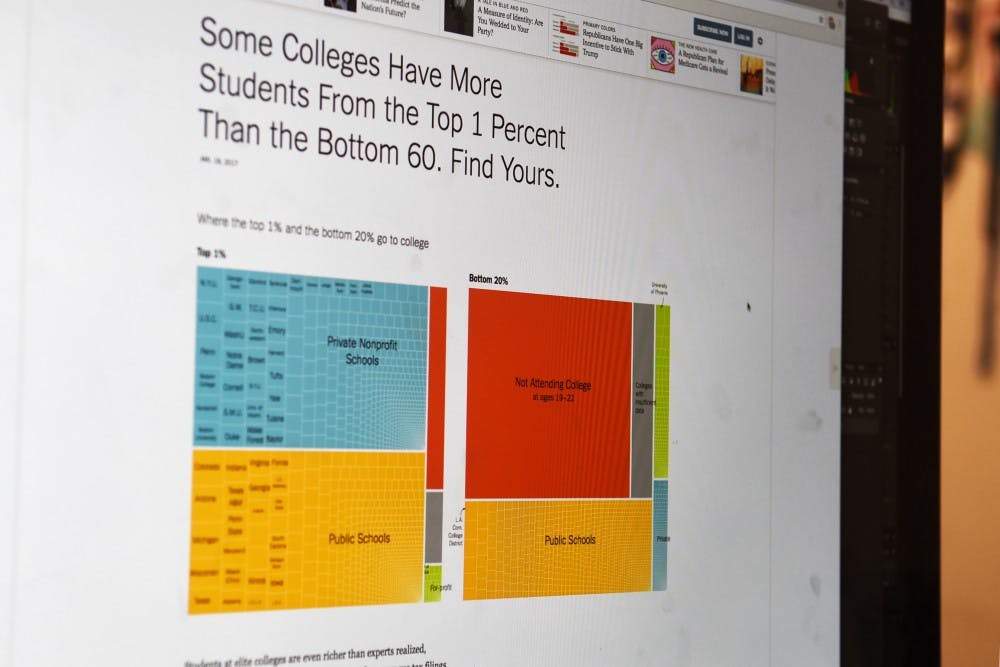
A recent infographic by The New York Times made waves in the world of higher education. The report highlights a study that examined the socioeconomic diversity of nearly 2,400 U.S. colleges.
According to the report, Penn undergraduates’ median family income of $195,500 would be in the 82nd percentile among U.S. families. The study found that Penn is one of 38 colleges — and five in the Ivy League — that had more students come from the top one percent of household incomes — 18.7 percent — than from the bottom 60 percent, which comprises 16.5 percent of Penn undergraduates.
The authors of the study obtained anonymous data from the Department of Education and federal income tax returns to analyze college attendance and parent incomes among individuals born between 1980 and 1991.
This report follows a Brandeis University study published last October that concluded that none of the 1,113 Penn undergraduates surveyed resided in zip codes considered in the bottom 20 percent of median incomes.
In response to the report, Dean of Admissions Eric Furda noted that Penn has expanded its financial aid program, enabling financial aid recipients to pay less than they had in the past.
“I don’t want anyone to lose perspective that under President Gutmann, our financial aid has increased over 160 percent,” Furda said. “Over $200 million per year are going into need-based financial aid, and families receiving financial aid at Penn are actually paying less than they did ten years ago.”
In a statement provided to The Daily Pennsylvanian, University spokesperson Karen Hamilton said, “Our numbers relative to socioeconomic diversity tell a far different story,” citing the 46 percent of Penn undergraduates who received an average of $45,368 in grant aid this year.
1986 Wharton graduate Laurie Kopp Weingarten, co-founder and director of One-Stop College Counseling, characterized the report as “sobering” and pointed out that middle-class families feel especially excluded from a Penn education due to their inability to afford the $69,340 total cost of attendance without sufficient financial aid.
“When I say that [approximately $70,000] figure to some of the parents, families or to other people not in the industry, they look at me like either I’m lying or I’m insane,” Weingarten said. “It’s really hard to grasp that sending your child to Penn is over a quarter million dollars after tax money if you don’t get financial aid, and a lot of people don’t get financial aid.”
For College freshman Melissa Perez, the disproportionately small fraction of low-income students at Penn stems from a difference in access to opportunity. Perez said that the general mindset towards top-tier institutions at her high school differed greatly from that of other, wealthier high schools.
“Especially when you’re in an environment that’s not very nurturing, students will fall into that belief that they can’t go farther than where they already are,” Perez said.
Furda noted that the conversation surrounding such reports often belies his belief that Penn already boasts a student body that runs the entire gamut of socioeconomic backgrounds.
“Should there be more students from the bottom quarter on Penn’s campus, and other campuses? Absolutely,” Furda said. “There’s going to be people in the bottom 10 percent, the top 10 percent, the bottom couple of percent, and the top couple of percent. And I think particularly given the way our country is right now, what we’re trying to build here is some opportunity that students are learning from each other. And that’s going to include students across the socioeconomic spectrum.”
Furda said he believes that students of all socioeconomic backgrounds have the potential to contribute to Penn in their own way.
“When you think about a young person and the perspective that they bring, that’s their perspective,” Furda said. “I don’t think anyone should be excluded from that equation, regardless of where you are, whether you’re a Pell Grant recipient or in the top one percent.”
The Daily Pennsylvanian is an independent, student-run newspaper. Please consider making a donation to support the coverage that shapes the University. Your generosity ensures a future of strong journalism at Penn.
Donate







